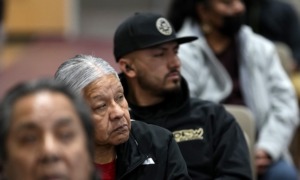CHICAGO – Don’t tell D’Andray Jackson hope is lost; he’ll have none of it.
His arms tucked inside a sweatshirt on a cool morning, D’Andray shrugs off the hard math that suggests he, as a young black male, isn’t supposed to make it.
His school, Beidler Elementary on Chicago’s west side, ranked 1,531 out of 2,068 elementary schools statewide. It’s a poor showing, but with 26 percent of the students meeting state averages in reading and math – up from just 2.7 percent eight years ago – there have been gains.
“I have a lot of hope,” said D’Andray, 15, an eighth-grader standing atop busted concrete early on a school day. Asked about career dreams, he shoots high.
“I’m thinking business,” he said. “The CEO of something, anything. … It is crazy, but yeah, I’ve got hope.”
D’Andray’s hope belies the employment record for black youth.
The black youth (ages 16 to 19) unemployment rate for April was 38.2 percent, compared with the white youth unemployment rate of 22.8 percent. Experts say the employment rate is a more telling figure. In April, just 15.5 percent of black youth were employed, compared with 28.3 percent of white youth the same age.
White young people 20 to 24 years old had an unemployment rate of 7.8 percent, compared with blacks in the same age range, who had an unemployment rate of 11.5 percent.
Education is one of the prime requirements for obtaining and keeping a job, according to the experts, and with the high school dropout rate for black youth nearly twice that of white youth, blacks’ employment will be affected throughout their lives.
U.S. Department of Education statistics show that 5.2 percent of white youth between the ages of 16 and 24 are high school dropouts, while 9.6 percent of black youth in the same age range have dropped out. But those numbers do not reflect the overall percentage of the workforce without high school diplomas.
Few jobs without a diploma
While the national unemployment rate stood at 8.1 percent in April, according to the Bureau of Labor Statistics (BLS), the unemployment rate for whites without a high school diploma was 11.7 percent and the unemployment rate for blacks without a diploma was 20.1 percent.
Here in D’Andray’s neighborhood, the effects of the recession have played out large. Homes and businesses are boarded up and shuttered. Public workers, previously in the most stable of jobs, have been laid off, as state and city budgets have adjusted to shrinking revenues.
“What’s going on, right?” said Joshua Lindsey, echoing Marvin Gaye’s signature line, as he stood before a mural of the late vocalist.
Lindsey, 30, who grew up on Chicago’s far south side, was strapping on a safety vest for a temporary job at a construction site under the elevated tracks on Chicago’s near west side. He has been shifting jobs, shuffling shifts and trying to make ends meet most of his working life.
It’s a fate that may befall thousands of black youths, including those unable to land the summer jobs that often are crucial for their families’ well-being.
Some 31 percent of black youth were unemployed that month, twice the percentage of whites and 11 percentage points higher than Hispanics.
The youth employment rate is top-of-mind for many these days, including those in the race for the White House. Presumptive Republican nominee Mitt Romney took a shot at the Obama administration in April, saying the “youth unemployment rate is double the unemployment rate for all Americans.”
The PolitiFact website analyzed the numbers and Romney’s claim. While the group mostly sided with Romney’s conclusions that the rate of unemployment is much higher for youth, it was not an embarrassment to be thrown in President Barack Obama’s lap. In fact, PolitiFact found, analyzing Bureau of Labor Statistics numbers, that the ratio of black to white youth unemployment rates has remained pretty much steady since George W. Bush took office in January 2001.
Efforts by the Obama administration to put a lid on youth unemployment have not kept pace with job losses during the five-year economic downturn. Among other things, the administration has touted increasing the ranks of AmeriCorps workers, who help disadvantaged neighborhoods and at-risk populations, to 83,000, as well as pumping billions into modernizing schools, and establishing a new $1.5 billion fund called the Pathways Back to Work to bridge the summer months with employment.
According to an analysis of BLS data, in the summer of 2007, just before the recession, a total of 7.2 million 16- to 19-year-olds were employed. Last summer, youth employment topped out at 5.2 million. In April, the number of 16- to 19-year-olds employed was 4.2 million.
These are not the statistics that Lindsey was raised to believe in. Nor do they even hint that the country has shaken much of the embedded racism and discriminatory schooling, hiring, housing and law enforcement that were hailed as being eliminated by civil rights victories more than 40 years ago.
“The youth these days … I tell them: ‘Make better decisions as you get older,’ ” Lindsey said. “Stay productive, because it’s all about the decision-making. … Growing up in these poverty-stricken areas, there’s a lot of vices, temptations to do things to make money quickly. Go to school. Work.”
The alternative is, very often, run-ins with the law. There has been an overall increase in the amount of public cash spent on policing, despite a recent study by the Justice Policy Institute that showed an often adverse correlation between investment in police and the dividends paid to society.
“More kids are being arrested for [minor] offenses, more jails are being filled, and more
Hope not lost — While unemployment among African-American young men may be at record highs, it isn’t keeping many, such as D’Andray Jackson, from dreaming big. I want to be “the CEO of something, anything… It is crazy, but yeah. I’ve got hope.”
people are ending up with records,” said Tracy Velazquez, the institute’s executive director. “And this makes it harder for them to get jobs and housing, and to go to school and better increase their education” and their chances at breaking free from the cycle. “There’s a trickle-up effect of costs through the whole system.”
The causes
Studies disagree with one another over the causes of high black unemployment and low employment numbers, especially among youth.
But most agree it starts with the schools.
Many minority youth, who this year showed progress in science and helped close the racial gap in test scores, are concentrated in urban settings. Most of the nation’s poorest performing schools – the highest dropout, truancy and early pregnancy rates; the lowest graduation rates; and the lowest number of students meeting state and national testing standards – are in urban settings.
“So many of the students that are at risk are hopeless and rudderless, and they really don’t believe that they can accomplish anything,” said Blondean Davis, a longtime Chicago educator and administrator who runs the successful Southland College Prep Charter High School just outside of Chicago. “But where is the charismatic leader? Where is this person who can say, ‘You can do this. I know you can do this. I have faith in you and I’m going to show you the way to do it?’ ”
Education is among the chief barometers of success, according to most employment studies, and the U.S. Department of Education recently found that, especially in Southern states, many schools were failing to graduate up to 70 percent of their high school students, setting up a generation of potentially lost youth caught in a wicked cycle of poverty and crime.
After all, where there is no income, there is little to tax – and with little to tax, there is not much to feed the public coffers needed to fund social programs that would, in turn, benefit the impoverished.
Poverty feeds off itself
In 2010, according to a study by the University of Wisconsin-Madison, some 15 million youth between the ages of 16 and 24 were ill-prepared to take on high-paying jobs. The report, citing the Center for Labor Market Studies, zeroed in on failed education and inadequate training as the chief culprits, and noted that holders of college diplomas made three times as much as high school dropouts.
Raising expectations
In Chicago, once called the worst school system in the nation, the rate at which public high school students went on to college went up 12 percentage points, to 55.7 percent, between 2004 and 2010, according to the system’s director for secondary school counseling, Barbara Karpouzian.
“We’re doing something right,” Karpouzian said, adding that the paradigm for counseling students has shifted over the past 10 years from therapeutic to a complete set of services focusing on academic, social and career possibilities.
“There’s been a lot of work, and we’re always giving them a message of hope,” she said. “We never say that the chances aren’t good. The desire is to begin the hope process as early as possible, to get them thinking of being a doctor as early as elementary school – in third or fourth grade.”
But there is the tricky period – summer – and especially the months between graduation and “the time they step on a college campus in the fall. There’s a gap that’s quite risky if we don’t fill it.”
Unemployment, studies show, leads to boredom, high-risk behavior and, very often, criminal activity or behavior that is interpreted as such in cities like Chicago.
“We can examine all of these actors, but somehow, there’s this embedded, structural racism seeping into the system,” said Alison Parker, the Cleveland-based director of Human Rights Watch’s U.S. Program.
You won’t get any argument about that point from Lindsey, the 30-year-old construction worker. “The system is set up against the black man,” he said. “Entirely. For whatever reason, I don’t know. Just plain hatred, and the only thing we can do is empower ourselves.”
Bonnie Wade is associate director at UCan, which works with minority and LGBT youth to move them out of the child welfare and justice systems and into everyday life.
“We have to look at it from a different lens,” she said. “It’s not just ‘This is what you’re up against, this is the trouble you’re facing and the deck is stacked.’ That is true – so true. But if there’s a way to punch with the truth while giving a caring hold at the same time, we can start from a strength-based place. For example, ask the kids: What do you know? You have everything inside you to succeed. You’ve made it to 18 or 20, or whatever. You’ve graduated or gotten your GED. You’ve done something right.”
Wade is optimistic about the promise of today’s at-risk youth. “Young people are resources themselves. They’re thoughtful, and we have to pull the promise out of them.”
Yet even Wade knows the rules of the game aren’t so fair. As Lindsey noted, once a kid runs afoul of the law – something that happens far more often in the open-air markets of urban cities than in private residences or properties in suburban or rural areas – it’s harder to hang on to that job. Once a job is lost, studies show that blacks face a longer wait – 27 weeks – to find a new job, compared with 19.7 weeks for whites and 18.5 weeks for Hispanics.
“When we get young people to believe and provide them the space and grace to dream,” Wade said, “then, as adults, we let them go and find out what they can do, there’s no telling where they can go with these lives. It’s not all big dreams. Maybe it’s working as a waiter, or making it in business or finding something else steady that’s a life you can hang your hat on. They’re kids; they make so many mistakes. But they can fly.”
Eric Ferkenhoff, a former Chicago Tribune reporter, is an assistant professor at Northwestern University. Darnell Little, also of Northwestern University, contributed to this report.































